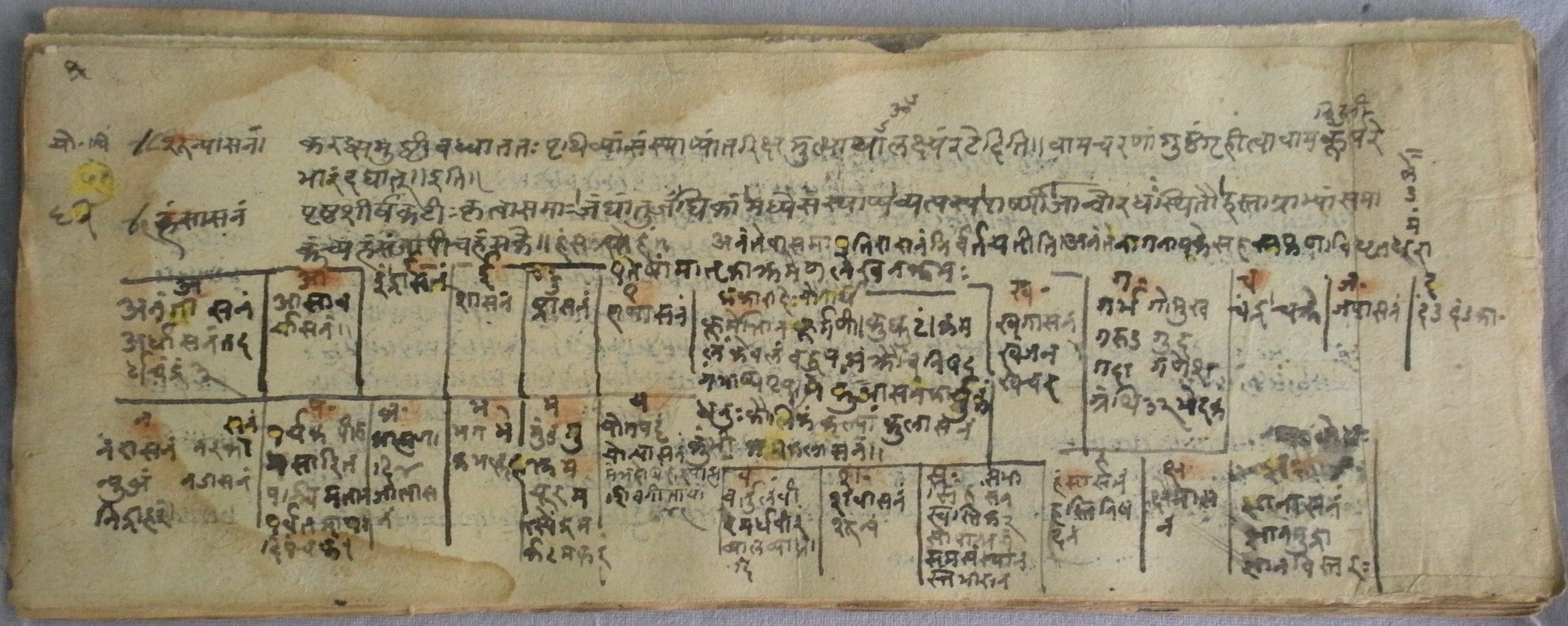Yogacintāmaṇi Folio 62v on:
[Wikipedia]
[Google]
[Amazon]
 The ''Yogacintamani'' is an early 17th-century
The ''Yogacintamani'' is an early 17th-century
 The ''Yogacintamani'' is an early 17th-century
The ''Yogacintamani'' is an early 17th-century hatha yoga
Haṭha yoga is a branch of yoga which uses physical techniques to try to preserve and channel the vital force or energy. The Sanskrit word हठ ''haṭha'' literally means "force", alluding to a system of physical techniques. Some haṭha ...
text, covering the eight auxiliaries of yoga. The asana
An asana is a body posture, originally and still a general term for a sitting meditation pose,Verse 46, chapter II, "Patanjali Yoga sutras" by Swami Prabhavananda, published by the Sri Ramakrishna Math p. 111 and later extended in hatha yoga ...
section in all the manuscripts describes 34 asanas, while variations in some manuscripts add another 84, mentioning most of the non-standing asanas used in modern postural yoga
Yoga as exercise is a physical activity consisting mainly of postures, often connected by flowing sequences, sometimes accompanied by breathing exercises, and frequently ending with relaxation lying down or meditation. Yoga in this form has ...
.
Text
The ''Yogacintamani'' (, IAST:) is an early 17th-centuryhatha yoga
Haṭha yoga is a branch of yoga which uses physical techniques to try to preserve and channel the vital force or energy. The Sanskrit word हठ ''haṭha'' literally means "force", alluding to a system of physical techniques. Some haṭha ...
text, its eight sections covering the eight auxiliaries of yoga., which cites The text quotes the ''Hatha Yoga Pradipika
The ''Haṭha Yoga Pradīpikā'' ( or Light on Hatha Yoga) is a classic fifteenth-century Sanskrit manual on haṭha yoga, written by Svātmārāma, who connects the teaching's lineage to Matsyendranath of the Nathas. It is among the most inf ...
'' extensively. The text is known from multiple manuscripts.
The asana
An asana is a body posture, originally and still a general term for a sitting meditation pose,Verse 46, chapter II, "Patanjali Yoga sutras" by Swami Prabhavananda, published by the Sri Ramakrishna Math p. 111 and later extended in hatha yoga ...
section in all the manuscripts of the ''Yogacintamani'' describes 34 asanas including kukkutasana
Kukkutasana ( sa, कुक्कुटासन; IAST: ''Kukkuṭāsana''), Cockerel Pose, or Rooster Posture is an arm-balancing asana in hatha yoga and modern yoga as exercise, derived from the seated Padmasana, lotus position. It is one ...
, mayurasana
Mayūrāsana ( sa, मयूरासन) or Peacock pose is a hand-balancing asana in hatha yoga and modern yoga as exercise with the body held horizontal over the hands. It is one of the oldest non-seated asanas.
Etymology and origins
The ...
, and siddhasana
Siddhasana ( sa, सिद्धासन; ) or Accomplished Pose, is an ancient seated asana in hatha yoga and modern yoga as exercise suitable for meditation. The names Muktasana (Sanskrit: मुक्तासन, Liberated Pose) and Burmese ...
, while variations in some manuscripts add another 84, mentioning most of the non-standing asanas used in modern postural yoga
Yoga as exercise is a physical activity consisting mainly of postures, often connected by flowing sequences, sometimes accompanied by breathing exercises, and frequently ending with relaxation lying down or meditation. Yoga in this form has ...
, including forward bends like paschimottanasana
Pashchimottanasana ( sa, पश्चिमोत्तानासन, translit=paścimottānāsana), Seated Forward Bend, or Intense Dorsal Stretch is a seated forward-bending asana in hatha yoga and modern yoga as exercise. Janusirsasana is a v ...
, backbends such as ustrasana
Ustrasana ( sa, उष्ट्रासन; IAST: ''Uṣṭrāsana''), Ushtrasana, or Camel Pose is a kneeling back-bending asana in modern yoga as exercise.
Etymology and origins
The name comes from the Sanskrit words उष्ट्र UṠ...
, twists like matsyendrasana
Matsyendrasana ( sa, मत्स्येन्द्रासन; IAST: ''Matsyendrāsana''), Matsyendra's Pose or Lord of the Fishes Pose, is a seated twisting asana in hatha yoga and modern yoga as exercise. The full form is the difficult P ...
, and arm balances like kukkutasana
Kukkutasana ( sa, कुक्कुटासन; IAST: ''Kukkuṭāsana''), Cockerel Pose, or Rooster Posture is an arm-balancing asana in hatha yoga and modern yoga as exercise, derived from the seated Padmasana, lotus position. It is one ...
.
Kukkutasana is described in the same way as in the ''Vasishtha Samhita
The ''Vasishtha Samhita'' (Sanskrit: वासिष्ठसंहिता, ''Vāsiṣṭha Saṁhitā'', Vasishtha's Collection) is a 13th century medieval Vaishnavite text, one of the first to describe non-seated hatha yoga asanas including th ...
'' and the ''Hatha Yoga Pradipika'', but in the Ujjain manuscript someone in the second half of the 17th century has added a note that the pose "is effective for cleaning the channels"; this is a benefit ascribed to siddhasana
Siddhasana ( sa, सिद्धासन; ) or Accomplished Pose, is an ancient seated asana in hatha yoga and modern yoga as exercise suitable for meditation. The names Muktasana (Sanskrit: मुक्तासन, Liberated Pose) and Burmese ...
in the ''Hatha Yoga Pradipika''. The yoga scholar Jason Birch Jason Birch is a scholar of medieval hatha yoga and a founding member of SOAS's Centre for Yoga Studies.
Biography
Jason Birch gained his bachelor's degree in Sanskrit and Hindi at the University of Sydney. He won a Clarendon Scholarship to att ...
comments that the manuscript shows that yogis at that time were "willing to combine yoga techniques from ≈öaiva
Shaivism (; sa, शैवसम्प्रदायः, Śaivasampradāyaḥ) is one of the major Hindu traditions, which worships Shiva as the Supreme Being. One of the largest Hindu denominations, it incorporates many sub-traditions rangin ...
and
Vai·π£·πáava
Vaishnavism ( sa, वैष्णवसम्प्रदायः, Vaiṣṇavasampradāyaḥ) is one of the major Hindu denominations along with Shaivism, Shaktism, and Smartism. It is also called Vishnuism since it considers Vishnu as the ...
traditions".
References
{{Hatha yoga Hatha yoga texts